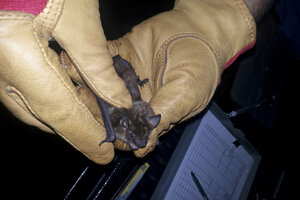Bat sonar: Have we been overthinking it?
Previously thought to be more complex, the mechanism by which bats use echolocation to navigate is surprisingly simple, say scientists.

In this July 20, 2015 photo provided by North Dakota State University in Fargo, an NDSU researcher holds a brown bat found during a field study.
Paul Barnhart, North Dakota State University/AP
Sometimes, a simple solution is just the thing for complex problem.
Science has produced a myriad of theories describing how bats use sonar to pilot in total darkness. But according to scientists at the University of Antwerp and the University of Bristol, the answer is actually quite straightforward. They suggest that echolocating bats choose maneuvers based on different signals in their left and right ears. Their findings appeared last week in the journal PLOS Computational Biology.
It’s no secret that bats use echolocation to “see” in the dark. By producing high-pitched calls that bounce off objects and return to the bat's ears, bats can determine the relative proximity of prey and of obstacles. But until now, researchers were unsure exactly how these nocturnal creatures navigated through forests and other environments.
In theory, bats could use biosonar to reconstruct entire surroundings – from there, they could plan their flight paths accordingly. But doing so in real time is extremely demanding from a computational perspective. Overlapping echoes and sonic dead zones could lead bats astray, or even cause collisions. The method is so convoluted that scientists aren’t even sure it’s possible.
“In spite of this, we know that bats are very good at avoiding obstacles,” lead author Dieter Vanderelst says. “So, the question is: how can they do it if locating obstacles is so hard?
To answer that fundamental question, researchers gathered extensive data – flight and behavioral patterns from echolocating bats, as well as laser-scanned models of actual forests. From that research, Dr. Vanderelst and colleagues developed 2D and 3D simulations, which led them to a surprisingly simple mechanism: that bats receive different echoes in the right and left ears. When an object is close, the corresponding echo is louder. So if a bat receives a comparatively loud signal in its left ear, it will respond by turning right to avoid the object, and vice-versa.
In other words, bats don’t have to map out their surroundings in advance. Instead, they react to obstacles intuitively.
“Nature has found many ingenious and simple solutions to problems that seem hard at first,” Vanderelst says. “The field of insect vision, navigation, and flight control is a good example of this.”
While Vanderelst’s original results were based on computer simulations, he and his colleagues are currently working with biologists to test living bat populations. In the meantime, they have already devised technological applications for the humble bat’s clever strategy.
“One application we are working towards is applying this strategy to robots,” Vanderelst says. “I believe biologically inspired sonar could be used to allow very small, unmanned aerial vehicles to fly and navigate under low light conditions. In micro aerial vehicles, sonar might be a lighter, smaller and less power hungry alternative to some of the sensors currently used in robotics.”

